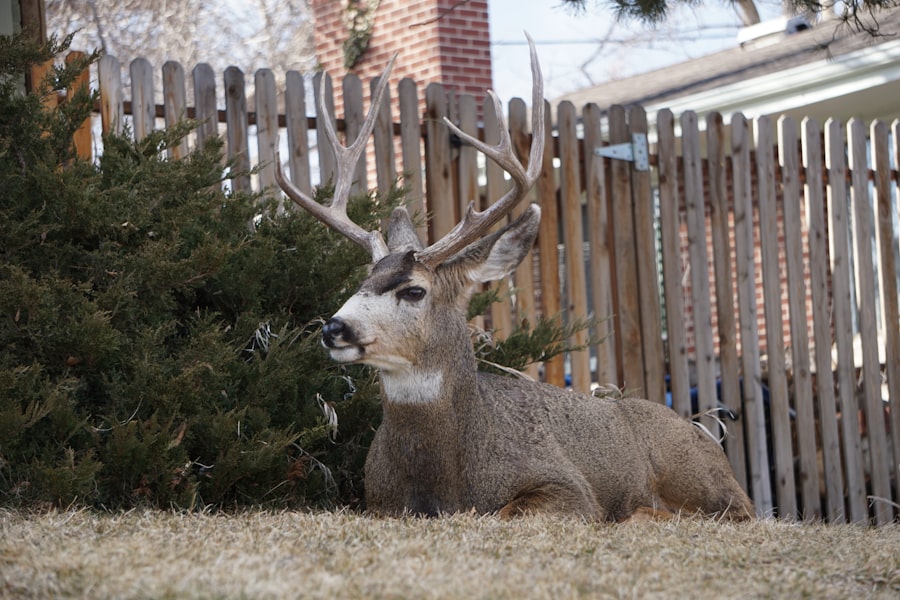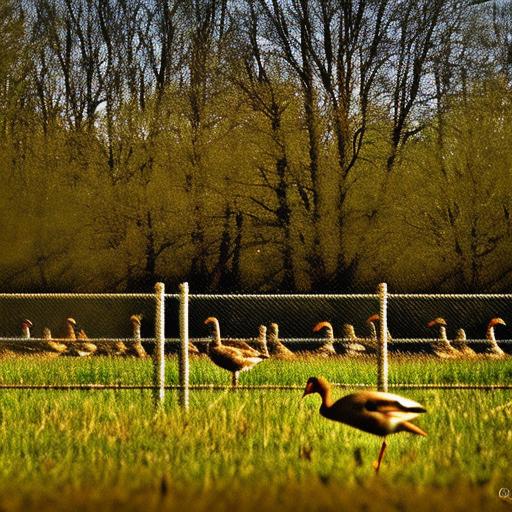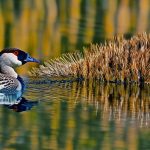Deer fences are commonly used to keep deer out of gardens and other areas where they can cause damage. However, these fences can also be effective in keeping geese away from certain areas. Geese can be a nuisance in many places, including parks, golf courses, and residential areas. They can cause damage to property, leave behind droppings that are unsightly and unsanitary, and even pose a threat to human safety. Therefore, it is important to find effective methods to keep geese away from these areas. Deer fences can provide a solution by creating a physical barrier that prevents geese from accessing these spaces.
Key Takeaways
- Deer fences can be effective in controlling geese populations.
- Deer fences can be used to keep geese away from crops, gardens, and other areas.
- There are different types of deer fences that can be used for geese control, including electric and non-electric options.
- Benefits of using deer fences for geese control include reduced damage to crops and decreased risk of disease transmission.
- Proper installation and maintenance of deer fences is important for long-term geese control.
Understanding the Need for Deer Fences to Keep Away Geese
Geese can be a problem in certain areas due to their feeding habits and behavior. They are attracted to open spaces with short grass, such as golf courses and parks, where they can easily find food. However, their presence can cause damage to these areas. Geese feed on grass and other vegetation, which can lead to bare patches and erosion. Their droppings are also a concern as they can create unsightly messes and pose health risks due to the bacteria they carry.
Deer fences can help keep geese away by creating a physical barrier that prevents them from accessing these areas. Geese are large birds that rely on open spaces for takeoff and landing. If they are unable to access these spaces due to the presence of a fence, they will be deterred from staying in the area. Deer fences are typically tall enough to prevent geese from flying over them, and they can also be designed with features such as angled tops or netting to further discourage geese from attempting to cross.
Types of Deer Fences Suitable for Geese Control
There are several types of deer fences that can be used for geese control. The most common types include polypropylene mesh fences, metal fences, and electric fences.
Polypropylene mesh fences are made from a durable plastic material that is resistant to weathering and UV rays. These fences are lightweight and easy to install, making them a popular choice for geese control. They can be installed as a permanent or temporary solution, depending on the needs of the area. Polypropylene mesh fences are also effective at keeping other animals out, such as rabbits and small mammals.
Metal fences, such as chain link or welded wire fences, are another option for geese control. These fences are more durable and long-lasting compared to polypropylene mesh fences. They can withstand harsh weather conditions and are difficult for geese to damage or break through. Metal fences can be installed with a top rail or angled top to further deter geese from attempting to cross.
Electric fences can also be used for geese control. These fences deliver a mild electric shock when touched, which acts as a deterrent for geese. Electric fences are effective at keeping geese away from specific areas, but they may not be suitable for all locations due to safety concerns.
Benefits of Using Deer Fences to Keep Geese Away
Using deer fences for geese control offers several benefits. Firstly, deer fences provide a physical barrier that prevents geese from accessing certain areas. This can help protect property from damage caused by geese feeding on grass and vegetation. It can also prevent the accumulation of droppings, which can be unsightly and unsanitary.
Deer fences are also more effective than other methods of geese control, such as scare tactics or repellents. Scare tactics, such as noise makers or visual deterrents, may work temporarily but often lose their effectiveness over time as geese become accustomed to them. Repellents can be expensive and may need to be reapplied frequently. Deer fences provide a long-term solution that does not require constant maintenance or additional costs.
Furthermore, deer fences can be customized to suit the specific needs of the area. They can be installed at varying heights and with additional features, such as angled tops or netting, to further deter geese. This flexibility allows for effective geese control in a wide range of environments.
How to Install Deer Fences for Effective Geese Control
Installing deer fences for geese control requires careful planning and execution. Here are some step-by-step instructions for installing deer fences:
1. Determine the area that needs to be protected: Identify the specific areas where geese are causing problems and need to be kept out. This could be a park, golf course, or residential property.
2. Measure the perimeter: Measure the length of the perimeter that needs to be fenced off. This will determine the amount of fencing material needed.
3. Choose the type of deer fence: Select the type of deer fence that is most suitable for geese control in the specific area. Consider factors such as durability, height, and additional features.
4. Prepare the area: Clear any vegetation or obstacles that may interfere with the installation of the deer fence. This includes removing rocks, tree stumps, and other debris.
5. Install fence posts: Dig holes for the fence posts along the perimeter of the area. The spacing between posts will depend on the type of fence being installed.
6. Set the posts: Place the fence posts in the holes and secure them with concrete or gravel. Ensure that they are level and sturdy.
7. Attach the fencing material: Unroll the fencing material along the perimeter and attach it to the fence posts using zip ties or other fasteners. Ensure that it is taut and secure.
8. Add additional features: If necessary, add additional features to the deer fence to further deter geese. This could include angled tops, netting, or electric wire.
9. Inspect the fence: Once the deer fence is installed, inspect it to ensure that there are no gaps or areas where geese could potentially enter. Make any necessary adjustments or repairs.
10. Maintain the fence: Regularly inspect and maintain the deer fence to ensure that it remains effective at keeping geese away. This includes checking for damage, repairing any issues, and clearing vegetation that may interfere with the fence.
Tips for Maintaining Deer Fences for Long-Term Geese Control

To ensure that deer fences remain effective at keeping geese away in the long term, regular maintenance is necessary. Here are some tips for maintaining deer fences:
1. Regularly inspect the fence for damage: Check the fence regularly for any signs of damage, such as holes, tears, or loose fasteners. Repair any issues immediately to prevent geese from finding a way through.
2. Clear vegetation around the fence: Trim back any vegetation that may be growing near or through the fence. This will prevent geese from using it as a perch to access the protected area.
3. Remove debris: Clear any debris, such as fallen branches or leaves, that may accumulate around the fence. This will help maintain the integrity of the fence and prevent geese from using it as cover.
4. Check for gaps or openings: Inspect the fence regularly to ensure that there are no gaps or openings where geese could potentially enter. Pay close attention to areas where the fence meets the ground or other structures.
5. Monitor geese activity: Keep an eye on geese activity in the area to determine if any adjustments or repairs to the fence are necessary. If geese are consistently attempting to cross the fence, additional deterrents may be needed.
Common Mistakes to Avoid When Installing Deer Fences for Geese Control
When installing deer fences for geese control, there are several common mistakes that should be avoided. These mistakes can compromise the effectiveness of the fence and allow geese to access the protected area. Here are some common mistakes to avoid:
1. Incorrect fence height: Ensure that the fence is tall enough to prevent geese from flying over it. Geese can fly at heights of up to 3 feet, so the fence should be at least 4-5 feet tall to be effective.
2. Gaps or openings: Check for any gaps or openings in the fence where geese could potentially enter. Pay close attention to areas where the fence meets the ground or other structures.
3. Inadequate anchoring: Make sure that the fence posts are securely anchored in the ground. This will prevent geese from pushing or pulling on the fence and potentially causing damage.
4. Lack of additional deterrents: Depending on the location and severity of the geese problem, additional deterrents may be necessary. These could include angled tops, netting, or electric wire.
5. Poor maintenance: Regular maintenance is essential for keeping deer fences effective at keeping geese away. Neglecting to inspect and repair the fence can lead to issues that allow geese to access the protected area.
Integrating Other Geese Control Measures with Deer Fences
While deer fences can be effective at keeping geese away, integrating other geese control measures can further enhance their effectiveness. Here are some methods that work well in conjunction with deer fences:
1. Habitat modification: Altering the habitat to make it less attractive to geese can help deter them from staying in the area. This can include removing short grass, planting tall vegetation, or creating barriers such as hedges or shrubs.
2. Scare tactics: Using scare tactics in combination with deer fences can help reinforce the message that the area is not suitable for geese. This could include noise makers, visual deterrents, or trained dogs.
3. Repellents: Applying repellents to the grass or vegetation can make it less appealing to geese. However, repellents should be used in conjunction with deer fences as they may not be effective on their own.
4. Egg addling: Removing or treating goose eggs can help control the population and reduce the number of geese in the area. This method should be done by trained professionals to ensure it is done safely and legally.
Cost Considerations for Installing Deer Fences for Geese Control
The cost of installing deer fences for geese control can vary depending on several factors. These factors include the size of the area that needs to be protected, the type of fence being installed, and any additional features or deterrents that are needed. Generally, polypropylene mesh fences are the most affordable option, while metal fences and electric fences can be more expensive.
It is important to consider the long-term cost savings that deer fences can provide. While the initial installation cost may be higher compared to other geese control methods, such as scare tactics or repellents, deer fences offer a long-term solution that does not require constant maintenance or additional costs. They are also more effective at keeping geese away, which can help prevent damage and reduce the need for costly repairs.
The Importance of Deer Fences for Keeping Geese Away
In conclusion, deer fences are an effective solution for keeping geese away from certain areas. Geese can cause damage to property, create unsightly messes, and pose health risks due to their feeding habits and behavior. Deer fences provide a physical barrier that prevents geese from accessing these areas, offering a long-term solution that is more effective than other methods of geese control.
When installing deer fences for geese control, it is important to choose the right type of fence and ensure that it is installed correctly. Regular maintenance is also necessary to ensure that the fence remains effective at keeping geese away. By integrating other geese control measures and considering the cost savings that deer fences can provide, property owners can effectively keep geese away and protect their property.
If you’re interested in keeping chickens and are looking for tips on where to put your chicken coop, you might find this article on Poultry Wizard helpful. It provides valuable insights on the ideal location for your coop, taking into consideration factors such as sunlight, ventilation, and predator protection. Additionally, if you’re wondering about the appropriate size for your chicken coop door, Poultry Wizard has another informative article that covers this topic. And if you’re curious about the best flooring options for your chicken coop, they have a comprehensive guide that explores different materials and their pros and cons. Check out these articles on Poultry Wizard to ensure you create a safe and comfortable environment for your feathered friends.
Meet Walter, the feathered-friend fanatic of Florida! Nestled in the sunshine state, Walter struts through life with his feathered companions, clucking his way to happiness. With a coop that’s fancier than a five-star hotel, he’s the Don Juan of the chicken world. When he’s not teaching his hens to do the cha-cha, you’ll find him in a heated debate with his prized rooster, Sir Clucks-a-Lot. Walter’s poultry passion is no yolk; he’s the sunny-side-up guy you never knew you needed in your flock of friends!







